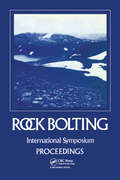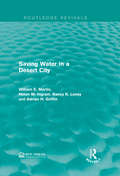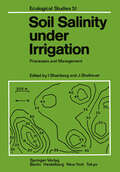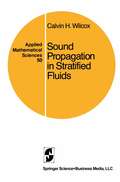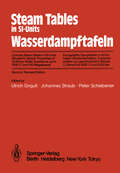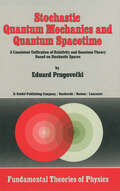- Table View
- List View
Rock bolting: Proceedings of the international symposium, Abisko, Sweden, 28 August-2 September 1983
by Ove StephanssonThis includes the Proceedings of the international symposium, Abisko, Sweden, 28 August-2 September 1983. Rock bolts today represent the dominant support system in mines and underground structures. Some results and experiences are discussed to give a better understanding of the strength of individual rock bolts and systems of bolts, and the interaction between bolts and rock masses of various types. Topics covered are as follows: rock bolting in theory and experiments; design principles and experience; and ground control and instrumentation: cable bolting.
Routledge Revivals: A Rural Policy for the EEC (Routledge Revivals)
by Hugh CloutFirst published in 1984, Hugh Clout’s work contributes to one of the most debated and important topics of the time, the European Economic Community. Starting from the Mid-20th century, Clout explains the profound socio-economic and environmental changes that effected the countryside of Western Europe. This work shows how the EEC’s wide-ranging Common Agricultural Policy added a measure of uniformity to farm policies. Clout reveals that the transformation however was not an entirely healthy one. The broad process of agricultural modernisation reinforced the numerical decline of farm workers throughout Western Europe, weakened many rural communities, and served to accentuate depopulation. Clout’s work ultimately argues forcibly that to produce such a programme for managing rural Europe would be a major challenge for the EEC in the future.
Routledge Revivals: A Rural Policy for the EEC (Routledge Revivals)
by Hugh CloutFirst published in 1984, Hugh Clout’s work contributes to one of the most debated and important topics of the time, the European Economic Community. Starting from the Mid-20th century, Clout explains the profound socio-economic and environmental changes that effected the countryside of Western Europe. This work shows how the EEC’s wide-ranging Common Agricultural Policy added a measure of uniformity to farm policies. Clout reveals that the transformation however was not an entirely healthy one. The broad process of agricultural modernisation reinforced the numerical decline of farm workers throughout Western Europe, weakened many rural communities, and served to accentuate depopulation. Clout’s work ultimately argues forcibly that to produce such a programme for managing rural Europe would be a major challenge for the EEC in the future.
Rural Development: Putting the last first
by Robert ChambersRural poverty is often unseen or misperceived by outsiders. Dr Chambers contends that researchers, scientists, administrators and fieldworkers rarely appreciate the richness and validity of rural people's knowledge or the hidden nature of rural poverty. This is a challenging book for all concerned with rural development, as practitioners, academics, students or researchers.
Rural Development: Putting the last first
by Robert ChambersRural poverty is often unseen or misperceived by outsiders. Dr Chambers contends that researchers, scientists, administrators and fieldworkers rarely appreciate the richness and validity of rural people's knowledge or the hidden nature of rural poverty. This is a challenging book for all concerned with rural development, as practitioners, academics, students or researchers.
Saving Water in a Desert City (Routledge Revivals)
by William E. Martin Helen M. Ingram Nancy K. Laney Adrian H. GriffinThis book was stimulated by and sets out to analyse a political battle over water pricing by a municipal system. Originally published in 1984, this title provides improved methods for demand function estimation where block rates are involved, suggests procedures for rational pricing of municipal water, and explains how politics can dominate when real decisions are made. Due to the additional virtue of this title being easy to read, it is ideal for students interested in environmental studies, economics, and policy making, as well as for those involved with municipal services and resource management in general.
Saving Water in a Desert City (Routledge Revivals)
by William E. Martin Helen M. Ingram Nancy K. Laney Adrian H. GriffinThis book was stimulated by and sets out to analyse a political battle over water pricing by a municipal system. Originally published in 1984, this title provides improved methods for demand function estimation where block rates are involved, suggests procedures for rational pricing of municipal water, and explains how politics can dominate when real decisions are made. Due to the additional virtue of this title being easy to read, it is ideal for students interested in environmental studies, economics, and policy making, as well as for those involved with municipal services and resource management in general.
Seabed Mechanics: Edited Proceedings of a Symposium, sponsored jointly by the International Union of Theoretical and Applied Mechanics (IUTAM) and the International Union of Geodesy and Geophysics (IUGG), and held at the University of Newcastle upon Tyne, 5–9 September, 1983
by International Union of Theoretical and Applied MechanicsSymposia do not just happen, and those which venture on the Bureau of IUT AM. I was on the train like a into new territory happen even less frequently. Never shot armed to the teeth with excuses. theless, faced by the challenge of organising such an I rehearsed my speech all the way down. I had event, many of us volunteer eagerly for the task. I am studiously opted for the environmental side of seabed not one of this select band. studies. I could prove it and produced papers on the Confronted by what at fIrst sight was but a casual correlation of geotechnical properties of the seabed invitation to consider whether I might be interested in with the populations of bugs that live there. Elsewhere commenting on the possibility I attended an informal (as in my defence package were items on landslips, clima I then thought) meeting at Newcastle University in 1980 tology, cluster analysis applied to business development to discuss the subject of Seabed Mechanics. Professor - anything I could find to illustrate my dissociation Len Maunder, Head of Mechanical Engineering here at from Seabed Mechanics proper.
Self-Organization: Autowaves and Structures Far from Equilibrium (Springer Series in Synergetics #28)
by V. I. KrinskyAccording to its definition, Synergetics is concerned with systems that produce macroscopic spatial, temporal, or functional structures. Autowaves are·a specific, yet very important, case of spatio-temporal structures. The term "autowave" was coined in the Soviet Union in analogy to the term "auto-oscillator". This is - perhaps too literal - translation of the Russian word "avto-ostsillyatory" (= self oscillator) which in its proper translation means "self-sustained oscillator". These are oscillators, e. g. , clocks, whose internal energy dissipation is compensa ted by a (more or less) continuous power input. Simi larly, the term "autowaves" de notes propagation effects - including waves - in active media, which provide spa tially distributed energy sources and thus may compensate dissipation. An example which is now famous is represented by spiral or concentric waves in a chemically active medium, undergoing the Belousov-Zhabotinsky reaction. This book provides the reader with numerous further examples from physics, chem istry, and biology - e. g. , autowaves of the heart. While the Belousov-Zhabotinsky reaction is now widely known, a number of very important results obtained in the Soviet Union are perhaps less well known. I am particularly glad that this book may help to make readers outside the Soviet Union acquainted with these important exper imental and theoretical findings which are presented in a way which elucidates the common principles underlying this kind of propagation effects. Professor V.
Self-Organization and Management of Social Systems: Insights, Promises, Doubts, and Questions (Springer Series in Synergetics #26)
by H. Ulrich G. J. B. ProbstSoil Salinity under Irrigation: Processes and Management (Ecological Studies #51)
by I. Shainberg J. ShalhevetThe importance of irrigation in the world's agriculture is rapidly increasing. Although it is practised on a large scale mainly in arid and semi-arid zones, supplementary irrigation is becoming popular in semi-humid regions as well. The record of irrigation speaks for itself in terms of increased crop production. However, the question remains as to how permanent the achievement may be. Judging from history, it seems that irrigation eventually failed in many regions because the knowledge and technology available to society at the time were incapable of coping with the problems created. Undoubtedly soil salinity is the most prevalent and widespread problem limiting crop productivity in irrigated agriculture. It has, therefore, attracted the attention of the scientific community since the advent of modern agronomic research. Through the past six to seven decades a considerable body of information has been accumulated, which has promoted the understanding of the principles involved and helped to develop the technology for coping with the problems. Our present knowledge, if judiciously applied, is adequate for coping with many of the salinity problems resulting from mismanagement of irrigation and drainage. But for this knowledge to be used, it has to be generally known and understood and be re-examined from time to time.
Sound Propagation in Stratified Fluids (Applied Mathematical Sciences #50)
by Calvin H. WilcoxStratified fluids whose densities, sound speeds and other parameters are functions of a single depth coordinate occur widely in nature. Indeed, the earth's gravitational field imposes a stratification on its atmosphere, oceans and lakes. It is well known that their stratification has a profound effect on the propagation of sound in these fluids. The most striking effect is probably the occurrence of acoustic ducts, due to minima of the sound speed, that can trap sound waves and cause them to propagate hori zontally. The reflection, transmission and distortion of sonar signals by acoustic ducts is important in interpreting sonar echoes. Signal scattering by layers of microscopic marine organisms is important to both sonar engi neers and marine biologists. Again, reflection of signals from bottom sediment layers overlying a penetrable bottom are of interest both as sources of unwanted echoes and in the acoustic probing of such layers. Many other examples could be given. The purpose of this monograph is to develop from first principles a theory of sound propagation in stratified fluids whose densities and sound speeds are essentially arbitrary functions of the depth. In physical terms, the propagation of both time-harmonic and transient fields is analyzed. The corresponding mathematical model leads to the study of boundary value problems for a scalar wave equation whose coefficients contain the pre scribed density and sound speed functions.
State Apparatus: Structures and Language of Legitimacy (Routledge Revivals)
by Gordon L. Clark Michael DearOriginally published in 1984, State Apparatus contributes to the debate on the theory of the state through posing questions regarding the state’s form, function, and apparatus. The book begins by setting out the theoretical and methodological problems and reviewing the various Conservative, Liberal and Marxist theories in light of these. It discusses state activity, using specific case studies to clearly illustrate key points, such as the development of welfare systems in North America and Western Europe. It also explores the use of language under the state, the role of the legal apparatus within a capitalist system, and the "local state". The book concludes with a discussion of democracy and the crisis of legitimacy, and the issue of justice and the state. State Apparatus is a detailed and comprehensive text, ideal for those with an interest in the history, theory, form, and function of the state.
State Apparatus: Structures and Language of Legitimacy (Routledge Revivals)
by Gordon L. Clark Michael DearOriginally published in 1984, State Apparatus contributes to the debate on the theory of the state through posing questions regarding the state’s form, function, and apparatus. The book begins by setting out the theoretical and methodological problems and reviewing the various Conservative, Liberal and Marxist theories in light of these. It discusses state activity, using specific case studies to clearly illustrate key points, such as the development of welfare systems in North America and Western Europe. It also explores the use of language under the state, the role of the legal apparatus within a capitalist system, and the "local state". The book concludes with a discussion of democracy and the crisis of legitimacy, and the issue of justice and the state. State Apparatus is a detailed and comprehensive text, ideal for those with an interest in the history, theory, form, and function of the state.
The Statesman's Year-Book 1984-85 (The Statesman's Yearbook)
by John PaxtonThe classic reference work that provides annually updated information on the countries of the world.
Statistik-Übungen: im wirtschaftswissenschaftlichen Grundstudium (Heidelberger Taschenbücher #237)
by T. Deutler M. Schaffranek D. SteinmetzSteam Tables in SI-Units / Wasserdampftafeln: Concise Steam Tables in SI-Units (Student’s Tables) Properties of Ordinary Water Substance up to 1000°C and 100 Megapascal / Kurzgefaßte Dampftafeln in SI-Einheiten (Studententafeln) Zustandsgrößen von gewöhnlichem Wasser und Dampf bis 1000°C und 1000 bar
by U. Grigull J. Straub P. SchiebenerStochastic Methods and Computer Techniques in Quantum Dynamics: Proceedings of the XXIII. Internationale Universitätswochen für Kernphysik 1984 der Karl-Franzens-Universität Graz at Schladming (Steiermark, Austria), February 20th - March 1st, 1984 (Few-Body Systems #26/1984)
by H. Mitter L. PittnerThis volume contains the written versions of lectures held at the "23. Internationale Universit~tswochen fUr Kernphysik" in Schladming, Austria, in February 1984. Once again the generous support of our sponsors, the Austrian Ministry of Science and Research, the Styrian Government and others, had made it possible to organize this school. The aim of the topics chosen for the meeting was to present different aspects of stochastic methods and techniques. These methods have opened up new ways to attack problems in a broad field ranging from quantum mechanics to quantum field theory. Thanks to the efforts of the lecturers it was possible to take this development into account and show relations to areas where stochastic methods have been used for a long time. Due to limited space only short manuscript versions of the many seminars presented could be included. The lecture notes were reexamined by the authors after the school and are now published in their final form. It is a pleasure to thank all the lecturers for their efforts which made it possible to speed up publication. Thanks are also due to Mrs. Neuhold for her careful typing of the notes. H. Mitter L. Pittner Acta Physica Austriaca, Suppl. XXVI, 3-52 (1984) © by Springer-Verlag 1984 STOCHASTIC PROCESSES - QUANTUM PHYSICS+ by L. STREIT Universitat Bielefeld BiBoS D-4800 Bielefeld. FR Germany I.
Stochastic Phenomena and Chaotic Behaviour in Complex Systems: Proceedings of the Fourth Meeting of the UNESCO Working Group on Systems Analysis Flattnitz, Kärnten, Austria, June 6–10, 1983 (Springer Series in Synergetics #21)
by Peter SchusterThis book contains all invited contributions of an interdisciplinary workshop of the UNESCO working group on systems analysis of the European and North American region entitled "Stochastic Phenomena and Chaotic Behaviour in Complex Systems". The meeting was held at Hotel Winterthalerhof in Flattnitz, Karnten, Austria from June 6-10, 1983. This workshop brought together some 20 mathematicians, physicists, chemists, biologists, psychologists and economists from different European and American coun tries who share a common interest in the dynamics of complex systems and their ana lysis by mathematical techniques. The workshop in Flattnitz continued a series of meetings of the UNESCO working group on systems analysis which started in 1977 in Bucharest and was continued in Cambridge, U.K., 1981 and in Lyon, 1982. The title of the meeting was chosen in order to focus on one of the current problems of the analysis of dynamical systems. A deeper understanding of the vari ous sources of stochasticity is of primary importance for the interpretation of experimental observations. Chaotic dynamics plays a central role since it intro duces a stochastic element into deterministic systems.
Stochastic Quantum Mechanics and Quantum Spacetime: A Consistent Unification of Relativity and Quantum Theory Based on Stochastic Spaces (Fundamental Theories of Physics #4)
by Margaret PrugoveckiThe principal intent of this monograph is to present in a systematic and self-con tained fashion the basic tenets, ideas and results of a framework for the consistent unification of relativity and quantum theory based on a quantum concept of spacetime, and incorporating the basic principles of the theory of stochastic spaces in combination with those of Born's reciprocity theory. In this context, by the physicial consistency of the present framework we mean that the advocated approach to relativistic quantum theory relies on a consistent probabilistic interpretation, which is proven to be a direct extrapolation of the conventional interpretation of nonrelativistic quantum mechanics. The central issue here is that we can derive conserved and relativistically convariant probability currents, which are shown to merge into their nonrelativistic counterparts in the nonrelativistic limit, and which at the same time explain the physical and mathe matical reasons behind the basic fact that no probability currents that consistently describe pointlike particle localizability exist in conventional relativistic quantum mechanics. Thus, it is not that we dispense with the concept oflocality, but rather the advanced central thesis is that the classical concept of locality based on point like localizability is inconsistent in the realm of relativistic quantum theory, and should be replaced by a concept of quantum locality based on stochastically formulated systems of covariance and related to the aforementioned currents.
Stoves and Trees: How Much Wood Would a Woodstove Save If a Woodstove Could Save Wood? (Routledge Library Editions: Forestry)
by Lloyd Timberlake Gerald Foley Patricia MossOriginally published in 1984, Stoves and Trees asks whether better stoves really help the two billion people in the developing world who rely on wood and charcoal for cooking and heating their homes. It also asks if improved stoves actually save fuel and if they can help slow down tropical deforestation. The book not only examines newer stoves but also ascertains how people buy, collect and use wood in the developing world. It finds that most forests are cleared for timber or farmland not fuelwood and explains why stoves which show 50% energy savings in European laboratories often save little or none in village homes.
Stoves and Trees: How Much Wood Would a Woodstove Save If a Woodstove Could Save Wood? (Routledge Library Editions: Forestry)
by Lloyd Timberlake Gerald Foley Patricia MossOriginally published in 1984, Stoves and Trees asks whether better stoves really help the two billion people in the developing world who rely on wood and charcoal for cooking and heating their homes. It also asks if improved stoves actually save fuel and if they can help slow down tropical deforestation. The book not only examines newer stoves but also ascertains how people buy, collect and use wood in the developing world. It finds that most forests are cleared for timber or farmland not fuelwood and explains why stoves which show 50% energy savings in European laboratories often save little or none in village homes.
Superconductivity in Magnetic and Exotic Materials: Proceedings of the Sixth Taniguchi International Symposium, Kashikojima, Japan, November 14–18, 1983 (Springer Series in Solid-State Sciences #52)
by T. Matsubara A. KotaniThe sixth Taniguchi Symposium on the Theory of Condensed Matter was held between 14-18 November 1983 at Kashikojima. Japan. During the Symposium, about twenty participants lived together and discussed the magnetic super conductors and related problems in an active and friendly atmosphere. This volume contains the papers presented at this Symposium. A strong impetus for organizing a Symposium of this subject is afforded by recent intense interest and accumulated information on magnetic and other novel superconductors newly discovered, and indeed the Symposium has pro duced many excellent contributions to this very exciting field of condensed matter theory, as reported in this volume. In order to give the readers a general outline of the subject, a brief sketch of the problem is made in the Introduction. Then the remainder of this volume is divided into four Parts and an Appendix. Part I is devoted to di scuss ions on several aspects of ferromagnetic superconductors includ ing superconductivity in heavy fermion systems. Part II treats problems on anti ferromagnetic superconductors. In Part III three papers on organic supercon ductors are presented. Part IV includes discussions on the exotic supercon ductors. The Appendix is concerned with the new research project towards high Tc superconductors in Japan. The last but not least remark is to mention the activity of the Taniguchi Foundation whose support makes this Symposium possible. For many years Mr.
Synergetics — From Microscopic to Macroscopic Order: Proceedings of the International Symposium on Synergetics at Berlin, July 4–8, 1983 (Springer Series in Synergetics #22)
by E. FrehlandSyngenesis and Epigenesis in the Formation of Mineral Deposits: A Volume in Honour of Professor G. Christian Amstutz on the Occasion of His 60th Birthday with Special Reference to One of His Main Scientific Interests
by A. Wauschkuhn C. Kluth R. A. ZimmermannThe papers in this volume are dedicated to Professor Dr. Dr. h.c. G. Christian Amstutz by his colleagues, friends, and students on the occasion of his 60th anniversary. The authors of this book - the theme was restricted to syngenesis and epigenesis in the formation of mineral deposits - wish to honour with their articles a scientist who has contributed to, and substantially promoted the understanding of the genesis of mineral deposits in the last decades. The majority of the articles deal with strata-bound depos its, thus reflecting one of his main scientific interests. In the tradition of his professors, Paul Niggli and Paul Ramdohr, G.C. Amstutz has maintained an open and active interest in many fields of earth science. His numerous papers have triggered a remarkable number of new ideas and investigations in a variety of fields, and the "happy marriage" of economic geology with sedimentology is cer tainly one of his main successes, starting with the first Symposium on Sedimentology and Ore Genesis at the Sixth International Sedimentological Congress at Delft in 1963.
